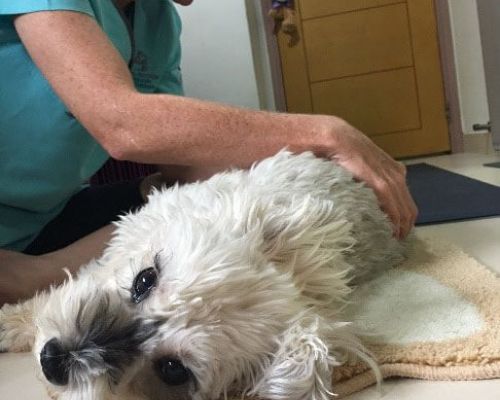Aging is a natural process that affects every living thing. Age itself is not a disease but pain is! Joint pain, stiffness, soreness and loss of strength and mobility all raise extra challenges that affect their activity and enjoyment of life.
Bone & joint problems
Nerve degeneration
Obesity and weight gain
Weakness - loss of strength
Vision/hearing loss
Brain aging
Aging gracefully and maintaining quality of life are vital in caring for senior and geriatric pets. Massage therapy, heat therapy, therapeutic laser and pulsed electromagnetic field therapy are very therapeutic, reducing soreness and stiffness. In addition to being used for chronic conditions such as osteoarthritis, laser and massage therapy have energising benefits that help to maintain comfort and quality of life in aging cats, dogs and rabbits.
A gentle fitness exercise programme and nutritional advice, including advice on supplements for senior pets, can help older pets to achieve or maintain an appropriate weight for their condition and stage of life, to promote their fitness and well-being. We review their medical conditions, considering any other issues and tailor our treatment plan to the unique needs of your pet. If needed, we can also guide you in assessing and monitoring your pet’s quality of life.
In older patients, often multiple legs, joints, muscles are affected, making it tricky to see obvious signs of lameness, and instead you may just notice your pet is reluctant to move or play, less willing to walk, or stiff after resting. Coupled with the changes to the senses and brain with age, it can be difficult for your pet as well as you to understand what is going on, and why their mobility and activity is impacted. Look out for early signs such as:
Cats are very used to hiding their problems. We also find that cats will often have issues in both sides (both elbows, both hips etc) which means they may be equally sore on both front or back legs. Cats will often reduce their activity, change their behaviour or change the usual places they like to rest (because they are easier to get to).
At Paws in Motion, we do not limit the benefits of physiotherapy to patients recovering from injuries or illness, but also support dogs, cats and rabbits in their individual aging journey.

Muscle pain and discomfort is debilitating. Keeping muscles comfortable is essential in maintaining movement and activity in older pets. Therapeutic massage is used to treat muscle tension and tightness which occur secondary to joint and neurological diseases.

Whilst your veterinary surgeon may prescribe a combination of medication to alleviate pain; physiotherapy allows us to combine several additional therapies, techniques and modalities to further reduce and manage pain.

Laser therapy is a painless and non-invasive technique which relaxes muscles and releases endorphins from the brain, making this treatment very comfortable for the pet. Laser therapy can be used to help pets with musculoskeletal pain, tissue swelling, inflammation, muscular strains and sprains, osteoarthritis, nerve degeneration, and also to deliver laser-puncture (acupuncture via laser).

Antioxidants help to repair damage to the cells in the body. They are very useful in helping to protect the brain’s neurons from the effects of brain aging and help with calming anxious pets. Joint supplements with key ingredients found in bioactive green lipped muscle and deer velvet, can help to repair damage to the cells in the body. They are extremely useful in improving joint health and comfort, as well as helping to protect the joint structures from wear and tear.

Weight management needs consideration of both calories and macronutrients when calculating feeding quantities of different diets. Our veterinary team will suggest tips based on our vast experience of how to help your pet get to their optimal weight.

At higher frequencies, NMES is used to stimulate motor nerve fibres of weak muscles which results in muscle contraction to help in the strengthening of the muscle. NMES is most often used in patients that are too weak to move certain muscle groups – muscles that have atrophy or loss due to disuse after injury or from neurological disease.

Digital infrared thermal imaging with Digatherm helps us to visualise the pain and inflammation with a non-invasive physiological body scan that evaluates your pet’s circulation, neurological and musculoskeletal function. Thermal imaging is not a diagnosis, but a step to help us to target our treatments and identify underlying issues in older pets with multiple areas of discomfort.

The Stance Analyser quantifies your dog’s weight distribution through each leg to provide an accurate reading and removes the guesswork involved. The readings help to identify problem areas as part of the physiotherapy consultation and we can monitor your pets' ongoing therapy and response. This is a fast, simple and non-invasive way to monitor your pet’s stance.
Our process for senior pets with arthritis or other age-related problems.
1
Initially we need to collect as much information as possible about your pet and your concerns; we will send you a detailed online questionnaire to complete. We will also reach out to your family veterinarian and /or specialist for your pet’s full medical history.
2
At our physiotherapy initial consultation, we assess the gait and movement of your pet, review the medical history and perform a thorough physical assessment to determine which parts of their neurological and musculoskeletal systems are affected.
3
Working together with you, we then devise a physiotherapy and rehabilitation treatment plan which meets the needs and goals of your individual pet. The treatment plan will generally include a variety of therapies and home care for you to continue at home, alongside our treatments.
4
Regular physiotherapy re-assessments are made throughout the treatment period to ensure your pet is progressing well and to update any home exercises prescribed. The frequency varies depending on your pet’s needs.